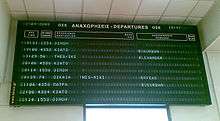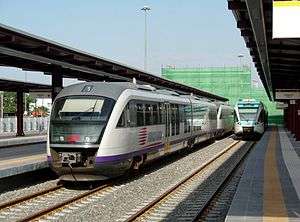TrainOSE
|
| |
| State-owned company, former OSE subsidiary | |
| Industry | Rail transport |
| Founded | 2005 |
| Headquarters | Athens, Greece |
Key people | |
| Products | Rail transport, cargo transport |
| Revenue |
|
|
| |
| Total assets |
|
| Total equity |
|
| Owner | HRADF[3] |
Number of employees | 679 (2015)[2] |
| Website |
trainose |
TrainOSE S.A. (Greek: ΤραινΟΣΕ Α.Ε., pronounced trenosé) is a railway company in Greece which currently operates all passenger and freight trains on OSE lines. The company, formerly a subsidiary of the Hellenic Railways Organisation (OSE), has been from 2008 an independent state-owned company. TrainOSE employs all train crews, operators and manages the rail services throughout the Greek railway network, but does not own any rolling stock, leasing rolling stock owned by OSE instead. TrainOSE is planned to be privatised (March 2016).[4]

main, secondary, under construction.
Privatisation
The Hellenic Republic Asset Development Fund has been the sole shareholder of the corporation since April 2013.[5] In July 2013, Hellenic Republic Asset Development Fund launched an international tender for the privatisation of TrainOSE.[6] Italian state railway group Ferrovie dello Stato Italiane submitted the only binding offer for a 100% stake in Greece’s national passenger and freight train operator TrainOSE, the Hellenic Republic Asset Development Fund announced on July 6, 2016.[7] On July 14th 2016, the privatisation agency accepted Ferrovie dello Stato Italiane's offer, worth 45 million euros, to buy 100% of TrainOSE.[8]
Domestic services
Mainline passenger services

TrainOSE operates three types of regional rail passenger services on which include "Regular" trains (Greek: Κοινή αμαξοστοιχία, regular/common train), Express trains (Greek: Ταχεία) and Intercity (IC) trains.
The regular rail service is the slowest, with trains making frequent stops, while it is also the cheapest available. Express trains are faster trains, making fewer stops in sections served by regular trains. Intercity (IC) trains are the fastest but the most expensive. The needed supplement on Intercity (IC) trains typically doubled or tripled the base fare respectively, but today this is determined more by the different competing forms of transport, mainly air transport. Car transport is also available on night services on the main line from Athens to Thessaloniki.
Passenger accommodation is similar in all classes of long distance trains. Seat reservation, bar and restaurant facilities are available on long distance express and on Intercity (IC) trains.
Numbering of the trains is determined by the type of the train. Regular trains (and also Proastiakos suburban/commuter rail service trains) have four-digit train numbers, Express trains have three-digit train numbers and Intercity (IC) and Intercity trains have two-digit train numbers, preceded by the symbols IC.
The following table shows the situation as of August 2011.[9] Numbers indicate trains on each direction on weekdays (Monday-Friday), excluding public holidays.
| Service | Intercity (IC) | Express & regular |
|---|---|---|
| Athens-Thessaloniki | 6 | 1 |
| Thessaloniki-Alexandroupoli | 1 | 1 |
| Athens-Leianokladi[10] | 2 | |
| Athens-Chalkis | 11 | |
| Thessaloniki-Edessa | 11 | |
| Larissa-Volos | 9 | |
| Athens-Kalampaka | 1 | |
| Thessaloniki-Kalampaka | 1 | |
| Palaiofarsalos-Kalampaka | 2 | |
| Alexandroupoli-Ormenio | 3 | |
| Leianokladi-Lamia-Stylis | 12 | |
| Diakofto-Kalavryta | 3 | |
| Larisa-Thessaloniki | 12 | |
Suburban/Commuter rail services between Piraeus - Athens - Athens International Airport and Kiato are not listed. In addition to the above regional rail services on the OSE network, TrainOSE also operates two suburban/commuter rail services on the remnants of the former Peloponesse metre gauge network:
- Katakolo to Ancient Olympia via Pyrgos
- Patras - Rio
A limited seasonal/tourist service of one train per day also operates as part of the Pelion railway.
| Journey | 2015 (April) |
|---|---|
| Athens – Thebes | 1:05 |
| Athens – lianokladi (Lamia) | 2:23 |
| Athens – Larisa | 4:00 |
| Athens – Thessaloniki | 5:23 |
| Thessaloniki - Serres | 2:04 |
| Thessaloniki – Alexandroupoli | 6:35 |
| Thessaloniki - Edessa | 1:22 |
| Source: Trainose |
Proastiakos commuter rail service
Proastiakos (Greek: Προαστιακός, meaning "suburban") is the name used for the suburban (commuter rail) services of TrainOSE in the Athens and Thessaloniki areas. Proastiakos was initially an independent subsidiary within the OSE group, but has since been merged with TrainOSE S.A. The network infrastructure, even if partly purpose-built for the Proastiakos service, is part of the national railway network of OSE, and as such is used by the regional rail services, even freight.

Proastiakos is a relatively new development, with the first service inaugurated for 2004 Athens Olympic Games, between Athens International Airport and Athens (via Neratziotissa station, close to the Olympic Stadium). The commuter rail services that are currently operated by Proastiakos include the lines on the 'main corridor' of Piraeus–Athens–Ano Liosia, Ano Liosia–Athens International Airport, Ano Liosia–Corinth–Kiato; and between the cities of Thessaloniki and Larissa.
The rolling stock of the Proastiakos commuter rail services include of Class 460 Siemens Desiro five-car electric multiple units (EMU), used on the electrified sections of the Ano Liosia–Athens International Airport, Ano Liosia–Corinth–Kiato and Thessaloniki–Larissa lines; while Stadler GTW 2/6 DMUs and MAN-2000 DMUs are used on the non electrified section between Piraeus–Athens–Ano Liosia.
In Athens, Poastiakos provides connections with ISAP (Metro Line 1) at Neratziotissa station, Athens Metro line 2 at Athens Central (Larissa station) and Athens Metro line 3 at Plakentias station; while it is also the only passenger rail service from Athens to Peloponnese, providing connections with the Peloponnese metre gauge network at Corinth and Kiato stations. This alone has somewhat played a wider role in providing actual regional rail links, than just being a pure suburban-commuter rail service.
Freight rail
As of February 2011 the current regular freight services of TrainOSE consist of:
- A night service from Agios Ioannis Rentis in Athens to the Thessaloniki marshalling yard
- A night service from Thessaloniki yard to Agios Ioannis Rentis
- A night service from Agios Ioannis Rentis to Agioi Anargyroi container unloading facility and back
Other irregular national and international freight services also exist.
International services

On 13 February 2011, due to the Greek financial crisis and subsequent budget cuts by the Greek government, all international services were suspended.[11] The Greek railway system used to connect with the railways of neighbouring countries Bulgaria at Promahonas (Koulata) and at Ormenion, with Turkey at Pythio and with the railways of the Republic of Macedonia at Idomeni.
The passenger services from Greece that ran to neighbouring countries until February 2011 were:
- Thessaloniki - Skopje - Belgrade
- Thessaloniki - Sofia - Bucharest
- Thessaloniki - Istanbul (Dostluk/Filia Express)
- Athens – Sofia
However, in May 2014 some international services were re-introduced on the following lines:[12]
- Thessaloniki - Skopje - Belgrade (interrupted from August 21, 2015 in reaction to the refugee situation[13])
- Thessaloniki - Sofia* Arrival train into Thessaloniki connecting with the 11pm service to Athens, thus being aimed at connecting passengers from Sofia to Athens.[14]
See also
- Hellenic Railways Organisation
- Proastiakos
- Railways of Greece
- Budapest–Belgrade–Skopje–Athens railway
References
- ↑ http://www.yme.gr/?getwhat=7&tid=21&aid=2199&id=
- 1 2 3 4 5 http://www.trainose.gr/wp-content/uploads/2014/03/ethsies_oikonomikes_katastaseis_etos_2015.pdf?8ca0bf
- ↑ "TrainOSE". hradf.com. Retrieved 14 July 2016.
- ↑ Kambas, Michelle (reporting); Koutantou, Aggeliki (reporting); Weir, Keith (editing) (21 March 2016). "Greece delays bid deadline for railway companies". Reuters. Retrieved 14 April 2016.
- ↑ "TrainOSE". hradf.com. Retrieved 14 July 2016.
- ↑ "Greece launches Trainose privatisation". railjournal.com. Retrieved 14 July 2016.
- ↑ "Greek railway privatisation attracts one bid". railwaygazette.com. Retrieved 14 July 2016.
- ↑ "Greece names Italian railways winner for Greece's TrainOSE". euronews.com. Retrieved 14 July 2016.
- ↑ TrainOSE timetable, valid from 19 June 2011. Some services were cancelled after the publication of the timetable.
- ↑ Train 1510 +3520
- ↑ "Important Greece Train Update". InterRail News. InterRailNet.com. Retrieved 19 July 2011.
- ↑ TrainOSE - International Railway Services
- ↑ "Travel disruptions in Europe due to refugee situation]". Interrail. 2015-09-18. Retrieved 2015-09-20.
- ↑ (Greek)
External links
![]() Media related to Rail transport in Greece at Wikimedia Commons
Media related to Rail transport in Greece at Wikimedia Commons